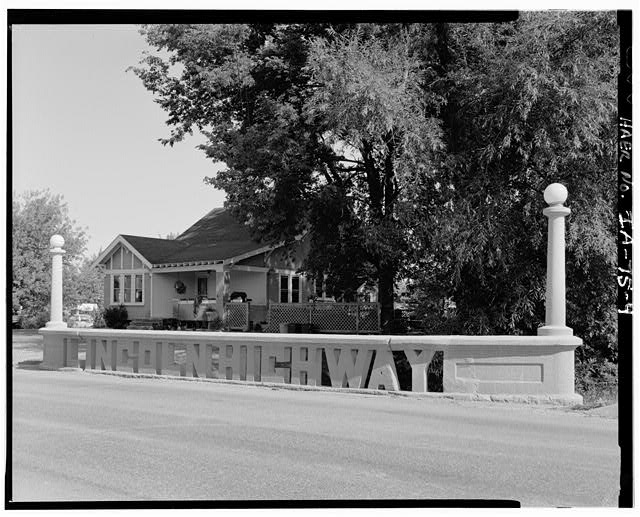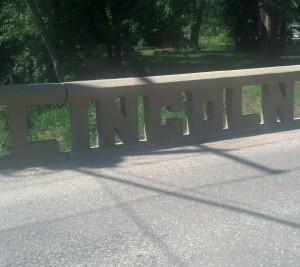
The Lincoln Highway Bridge in Tama, Iowa, taken sometime after 1968. (Historic American Engineering Record photo via Library of Congress >>)
TAMA, Iowa — For Lincoln Highway enthusiasts, a stop in this small town about an hour west of Cedar Rapids is mandatory. On its eastern approach into the town from the U.S. 30 expressway bypass — and just off an older local bypass — the Lincoln Highway travels over a short bridge spanning a small creek.
The concrete railing spells out “LINCOLN HIGHWAY.” It was a way for little Tama to stand apart from other towns proud to have the highway’s alignment go through their town. (Tama, in fact, hosts an annual Lincoln Highway Bridge Festival.)
By simply spelling two words out in concrete, this tiny town transformed the Lincoln Highway into its own modern monument. To the rest of the state, it showed that Tama wasn’t stuck in the mud.
Iowa’s often impassable dirt roads were notoriously bad. And there were disagreements on how to improve them or whether to improve them at all.
As was wonderfully detailed in Earl Swift’s The Big Roads, Iowa’s experience improving its roads impacted the rest of the nation when Thomas Harris MacDonald, the Iowa State Highway Commission’s young chief engineer later moved to Washington, D.C., and served for 34 years as the chief and commissioner of the federal Bureau of Public Roads. There, he helping direct Federal Aid funds to states to develop a national network of highways in the 1920s and 1930s. And that national network later helped pave the way to today’s Interstate Highway System.
But MacDonald got his start in Iowa. In American Road, Pete Davies wrote that MacDonald “had to work in the face of Iowa reluctance to pay for good roads; he could grade them, he could drain them and drag them, but he couldn’t pave them.”
Eventually, that all changed and Iowa was able to free itself from the mud. And as I’ve discovered on my trip, Iowa has pretty good roads compared to other states I’ve been in. Or at least that’s been the case along U.S. 30, which heads westward from the Tama area as a divided highway through the Marshalltown area and on toward Ames.
And I’m headed that way.

